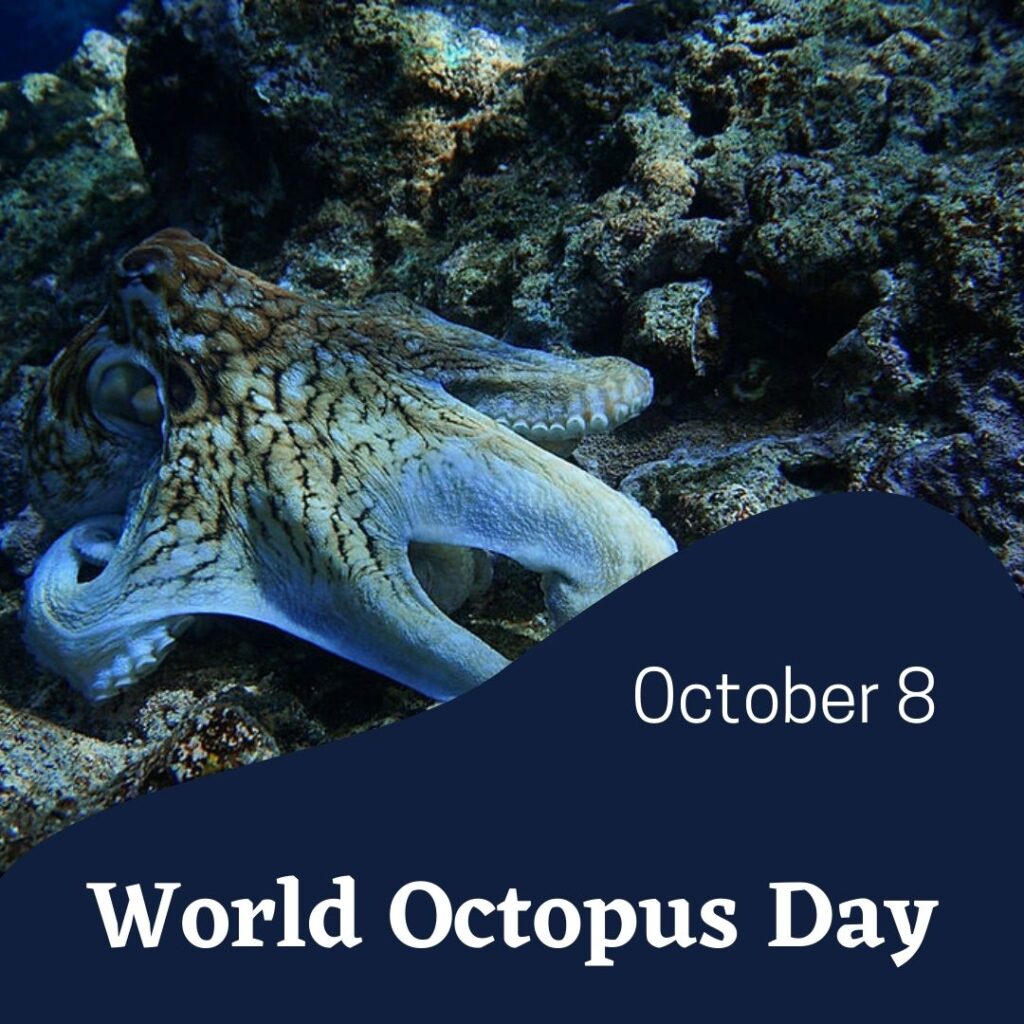World Octopus Day is an annual observance that takes place on October 8. This day celebrates one of the most bizarre and iconic creatures in the world. Octopuses are fascinating creatures and you can celebrate this day by learning more about them or taking a trip to a marine life center to see these eight-limbed mollusks.
World Octopus Day will be celebrated on Tuesday, October 8, 2024.

Interesting Facts about Octopuses
Let’s find out more about these stunning soft-bodied cephalopods on World Octopus Day.
They have 3 hearts, two hearts pump blood to the gills and the third one pumps blood throughout the rest of the body.
The color of their blood is blue – this is because of the copper-rich protein in their blood instead of iron.
The giant Pacific octopus is the largest of all species and also has the longest lifespan. The largest specimen ever recorded measured 30 feet across and weighed over 600 pounds.
The smallest species is Octopus Wolfi which measures about an inch long and weighs about a gram.
Most of their neurons are outside the brain, especially in their arms. This gives arms local control and sensory capabilities. Their arms will be able to reach and grasp even if they are separated from the body. Also, the suckers on their arms are able to smell and taste on their own. It is like having a mini-brain in each of their arms.
The blue-ringed octopus is one of the most venomous creatures of the sea. They are capable of gravely injuring or even killing humans with just one bite because their saliva contains a powerful nerve toxin that causes respiratory failure.
Blue-ringed octopuses have two separate venom glands to secrete two types of venoms, one for prey and one for the predators. The venom used against predators is much more toxic than the one used against prey.
They have a short lifespan as most of the species live between 1-2 years.
When octopuses mate, males are sometimes strangled and eaten by females once fertilization is complete. Males are often smaller than females so they are easily cannibalized by females.
Dumbo octopuses have fins on their head that resemble the ears of an elephant, hence the name dumbo octopus.
When threatened, these cephalopods may use their ink to distract, confuse, and paralyze their predators. This ink can impair a predator’s sight, smell, and taste. It can even block a fish’s gills causing the fish to suffocate. Octopuses also use the ink to disorient their prey before attacking.
The blue-ringed octopuses get their name for the blue rings that flash across their bodies when they are agitated or threatened. Their blue rings are not visible when they are at rest.
Did you know that an octopus can lose an arm to escape a predator’s grasp and regrow it later?
All eight legs of a dumbo octopus are connected by a web of skin.
These nature’s quirkiest creatures are experts in mimicry and camouflage. They can change color within milliseconds and some octopuses can also imitate the textures to match textured environments. In addition to that, species like mimic octopus can manipulate the shape of their bodies to impersonate other animals.
While mimic octopus mimics several animals, it can switch between them rapidly.
Dumbos are the deepest-living octopuses known as they are found up to 13,000 feet below the surface of the ocean.
These stunning creatures use their suckers to grip seafloor objects and sometimes collect crustacean shells and other objects to build fortresses around their lairs.
Their soft bodies allow them to squeeze through any crack and hole that is not smaller than their beak.
Female octopuses die shortly after laying and brooding the eggs. Females guard their eggs for up to eight weeks without eating anything and during this time their body self-destructs through cellular suicide.
The mimic octopus was discovered a few decades ago in 1998 off the coast of Sulawesi, Indonesia.
There is a species called the seven-arm octopus. Although they have eight arms but they get their name because in males the arm used in egg fertilization is coiled in a sac beneath the right eye and is easily overlooked giving the appearance of just seven arms.
Some octopuses have the ability to jet forward by expelling water through their mantles and can attain a top speed of 40km/h.
Octopus can die of its own ink. If an octopus cannot escape its own ink, its respiratory systems may give in causing death from suffocation.
Their predators include whales, seals, sharks, eels, dolphins, and other large fish, who like to gobble them up.
These captivating creatures of the deep are intelligent as they are able to play, use tools, retain complex memories that allow them to navigate mazes, and use visual cues. They have successfully opened jars and solved mazes in lab tests.
They really are intelligent! Interestingly the mimic octopus takes the form of a sea snake when bothered by damselfish which are preyed on by sea snakes.
Dumbo octopuses do not ink; probably because they live in so deep waters where they don’t need defense.

Related Events



